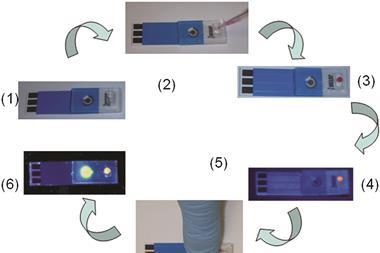Technique could one day allow diabetics to manage their condition without drawing blood

Scientists in Germany have developed a spectroscopy method to measure diabetics’ glucose levels through their skin.
When a sample is irradiated with IR light, it produces a temperature increase and when this heat diffuses to a material in contact with the sample, a temperature gradient is created, causing a thermal lens – just like the mirage effect you see in the air on the surface of a hot road. By examining the deflection of a probe beam across this lens, you can study the thermal and optical properties of the sample.
The new method from Miguel Ángel Pleitez, of Goethe University Frankfurt, and colleagues combines total internal reflection (TIR) and photothermal deflectometry (PTD) to measure the infrared spectrum of opaque and highly scattering samples. It uses a quantum cascade laser (QCL) as an excitation source to penetrate samples beyond what is traditionally possible with regular infrared (IR) spectroscopy.
‘TIR-PTD can be used as a general purpose sensing technique for spectroscopy; it is suitable for the study of liquid and solid samples as well as human tissue,’ explains Pleitez. ‘Therefore, we expect this technique to be used in a wide range of applications where the opacity of the sample has been, until now, an issue.’
To manage their diabetes, diabetics must prick a finger to test their blood glucose levels throughout the day. It’s uncomfortable and disruptive. TIR-PTD, however, can measure glucose levels found in the interstitial fluid beneath the skin, making it a non-invasive measurement tool. In this case, they tested it on the palm of a Type I diabetic, and were able to gain spectral information at depths at least 50µm below the skin surface.
Director of the optical imaging laboratory at Washington University in St Louis, US, Lihong Wang comments that mid-IR spectroscopy is a valuable tool for biomedical optics but that due to the light being strongly absorbing, little light is scattered back for direct detection. ‘This creative work based on the “mirage” effect overcomes these issues using the total internal reflection of a visible light beam. Moreover, the solid internal reflection element facilitates optical alignment and measurement.’
In the future the technique could make a difference in fields such as spectral histopathology and spectral cytopathology for quantitative cancer diagnosis. It could even be used in home care, though in order for this to happen the size and price of the laser source needs to be reduced.
‘Although there is still much work to do, from our part and from the QCL industry, we are optimistic that within a few years this kind of detector will be the core of a non-invasive glucose system,’ says Pleitez.
References
This article is open access. Download it here:












No comments yet